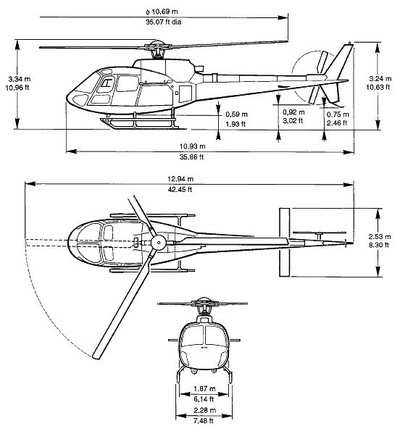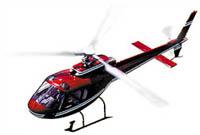Three People Were Fatally Injured When Air Taxi Aircraft Went
Down
 The NTSB has released its probable cause report for an
accident involving an air taxi helicopter in Avalon, CA two years
ago. The Safety Board says the probable cause of the accident was
loss of engine power during approach for landing due to a fatigue
fracture of a power turbine blade.
The NTSB has released its probable cause report for an
accident involving an air taxi helicopter in Avalon, CA two years
ago. The Safety Board says the probable cause of the accident was
loss of engine power during approach for landing due to a fatigue
fracture of a power turbine blade.
According to the probable cause report, the helicopter,
an Aerospatiale AS-350-D, was descending to the planned
destination during the on-demand air taxi flight when witnesses
reported hearing a loud pop, followed by flames emitting from the
back of the engine. The helicopter subsequently impacted the
ground.
A surviving passenger reported that just after the loud pop, the
pilot told passengers that he was going to autorotate. The
helicopter entered a descent at an altitude witnesses on the ground
estimated at 200 to 400 feet above ground level. During the
descent, the pilot had to clear numerous obstacles, including
buildings and power lines, to reach an open field located beyond
the obstacles but short of the normal landing area. The ground
witnesses stated that the helicopter was in an area near the
shoreline when they witnessed the flames and heard the loud pop;
however, the exact location in reference to the shoreline could not
be determined.
Since the pilot stated to passengers that he was going to
autorotate, it is likely that the helicopter experienced a loss of
power after the loud pop. In the event of a loss of engine power,
the pilot must enter an autorotation by immediately reducing the
collective pitch to maintain main rotor speed to avoid a main rotor
stall. The collective pitch must be reduced to the point required
to maintain, or regain a safe main rotor speed. This would allow
the pilot to maintain sufficient rotor speed while maneuvering to a
suitable landing area, and to arrest the descent when needed. If
the main rotor blades stall, this will ultimately result in a loss
of control and uncontrolled descent.

Because of the relatively low altitude at which the loss of
power occurred, it is likely that the accident pilot had to trade
rotor rpm to maintain the altitude needed to clear the obstacles
and reach the open field. This would have resulted in a lack of
sufficient rotor rpm to arrest the helicopter’s descent rate
as it approached the ground. Further, examination of the main rotor
blades at the accident scene did not show evidence of high
rotational energy at impact.
Postaccident inspection of the turbine engine revealed localized
damage to four consecutive power turbine blades. Two of the blades
were fractured transversely across the airfoil above the blade root
platform and two were fractured higher up their respective airfoils
near the blade tips. Generalized damage was observed to the
remaining power turbine blades; however, all blades were in place
and remained secured to the power turbine wheel. A Safety Board
materials engineer's examination of the fractured blades revealed
striation features typical of fatigue cracking on the pressure
(concave) side of the airfoil. The fatigue crack features emanated
from the boundary area between the base material and a casting pin.
Further analysis disclosed that the fracture was the result of
fatigue cracking that emanated from two platinum casting pins on
the pressure side of the blade adjacent to the platform. The
fracture face of the blade contained isolated regions of fatigue
cracking that were separated by fracture regions and showed
oxidation damage consistent with fatigue. Additional testing of the
fractured blade(s) indicated that the microstructure in the airfoil
portions showed no evidence of operation above a temperature
profile expected for this stage of the engine. The fracture
features of the remaining turbine blades were consistent with
overstress separation.

File Image
Review of maintenance records indicated that, the engine's cycle
counting process, inspection requirements, and compliance with
airworthiness directives and service bulletins were all
satisfactory. More specifically, due to the power turbine blade
failures, the life and maintenance history of the power turbine
rotor, including the power turbine blades, were assessed. The
information contained in the maintenance records, as well as the
information provided by the manufacturer on the history and
inspection requirements of the power turbine blades showed that
they were operated in accordance with the requirements set forth by
the manufacturer.
Following the accident, Honeywell Aerospace issued Service
Bulletins; LT 101-71-00-0252 and LTS101-71-00-0253. The Service
Bulletins require the removal and inspection of the turbine
assemblies, "To address a service related difficulty with Power
Turbine Rotor Blade Part No. 4-141-084-06 cracking at the mid span
of the airfoil that can lead to a blade separation and subsequent
inability to maintain powered flight resulting in potential
injuries and damage to the aircraft."
Two FAA Airworthiness Directives pertaining to this issue are
pending.
 ANN's Daily Aero-Linx (04.15.24)
ANN's Daily Aero-Linx (04.15.24) Classic Aero-TV: 'No Other Options' -- The Israeli Air Force's Danny Shapira
Classic Aero-TV: 'No Other Options' -- The Israeli Air Force's Danny Shapira Aero-News: Quote of the Day (04.15.24)
Aero-News: Quote of the Day (04.15.24) Airborne 04.16.24: RV Update, Affordable Flying Expo, Diamond Lil
Airborne 04.16.24: RV Update, Affordable Flying Expo, Diamond Lil ANN's Daily Aero-Term (04.16.24): Chart Supplement US
ANN's Daily Aero-Term (04.16.24): Chart Supplement US





